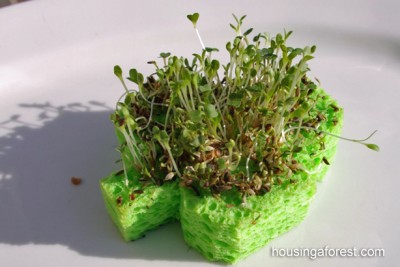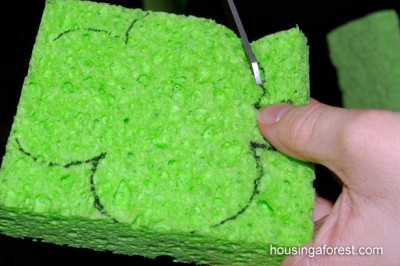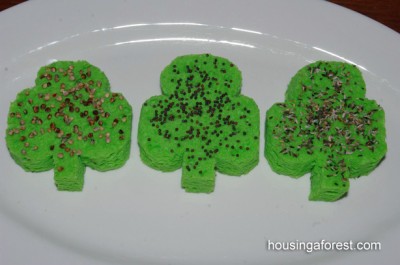Leprechaun Gardening – Shamrock Sprouts from Housing a Forest
When it comes to gardening, Leprechauns have a green thumb. That’s not to say that they really have a green-colored thumb (even though they do). It means that they are really good at growing plants. Leprechauns are so incredible at gardening that they don’t even need soil to grow their plants!
What You’ll Need
- Sponge (Green would be an excellent choice)
- Permanent marker
- Scissors
- Seed packet (Lettuce, spinach, or broccoli work great)
- Spray bottle
- Water
Let’s Try It!
- Use a permanent marker to trace a clover shape on a dry sponge. You get to choose whether you want a standard, three-leaf shamrock, or a lucky, four-leaf clover. If you want to compare the two (you know, for magical properties), trace each shape on a different sponge.
- Use a strong pair of scissors to cut the shamrock shape out of the sponge. This step can be difficult, so make sure you are extra careful and have an adult helper on hand… just in case. If the sponge is proving especially tricky to cut, try dampening it.
- Once your shamrocks are cut, soak them in water. You want your sponge to be damp, but not dripping. If you need to, you can squeeze off some of the water.
- Scatter a packet of seeds on the surface of the shamrock and gently poke them into the holes of the sponge.
- Place the seeded shamrock sponge in a sunny window sill. Use a spray bottle filled with water to keep the sponge moist. Depending on the humidity where you live, you’ll need to spray the sponges 1-3 times a day.
- Keep track of your sponge shamrocks and observe them often. Before you know it, you’ll have an entire garden of vegetable sprouts on your magical clovers!
St. Patrick’s Secrets
Whoa… those plants are growing without any soil! How in the wide world of Leprechauns are they doing that?!? The secret isn’t actually Leprechaun magic. Plants can grow without actual soil, but they cannot grow without what soil provides: support, nutrients, an even supply of moisture and oxygen around their roots. The plants that you grow on the sponges are just sprouts, or a young shoot of a plant. These tiny plants have all the support they need from the tiny holes within the sponge. The sponge’s porous, water-holding nature provides the plants with the even supply of moisture they require, as well as plenty of oxygen around the roots of the plants. Finally, just like you, plants can’t grow without the nutrients and minerals they need! Thankfully, water provides these young sprouts with all of their nutrient and mineral needs during their young lives.
This activity came to us from Tammy at Housing a Forest. Thank you for letting us share your great St. Patrick’s Day activity!







Ooh my little guys would love watching the plants grow! Great post. I’m pinning and want to try soon!
This sounds great i might try that!
can the sponges then be planted into a pot or directly into the garden?
I’m not completely positive, but I would bet they can be planted in a garden or pot. Just fill it with dirt and the roots will spread.